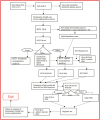Identifying determinants of spatial agglomeration of healthcare resources by using spatial econometric methods: a longitudinal study in China
- PMID: 38864022
- PMCID: PMC11165023
- DOI: 10.3389/fpubh.2024.1351849
Identifying determinants of spatial agglomeration of healthcare resources by using spatial econometric methods: a longitudinal study in China
Abstract
Background: Healthcare resources are necessary for individuals to maintain their health. The Chinese government has implemented policies to optimize the allocation of healthcare resources and achieve the goal of equality in healthcare for the Chinese people since the implementation of the new medical reform in 2009. Given that no study has investigated regional differences from the perspective of healthcare resource agglomeration, this study aimed to investigate China's healthcare agglomeration from 2009 to 2017 in China and identify its determinants to provide theoretical evidence for the government to develop and implement scientific and rational healthcare policies.
Methods: The study was conducted using 2009-2017 data to analyze health-resource agglomeration on institutions, beds, and workforce in China. An agglomeration index was applied to evaluate the degree of regional differences in healthcare resource allocation, and spatial econometric models were constructed to identify determinants of the spatial agglomeration of healthcare resources.
Results: From 2009 to 2017, all the agglomeration indexes of healthcare exhibited a downward trend except for the number of institutions in China. Population density (PD), government health expenditures (GHE), urban resident's disposable income (URDI), geographical location (GL), and urbanization level (UL) all had positive significant effects on the agglomeration of beds, whereas both per capita health expenditures (PCHE), number of college students (NCS), and maternal mortality rate (MMR) had significant negative effects on the agglomeration of institutions, beds, and the workforce. In addition, population density (PD) and per capita gross domestic product (PCGDP) in one province had negative spatial spillover effects on the agglomeration of beds and the workforce in neighboring provinces. However, MMR had a positive spatial spillover effect on the agglomeration of beds and the workforce in those regions.
Conclusion: The agglomeration of healthcare resources was observed to remain at an ideal level in China from 2009 to 2017. According to the significant determinants, some corresponding targeted measures for the Chinese government and other developing countries should be fully developed to balance regional disparities in the agglomeration of healthcare resources across administrative regions.
Keywords: China; agglomeration; determinants; healthcare resources; spatial econometric methods.
Copyright © 2024 Dong, Sun, Xi, Wang, Wang and Gao.
Conflict of interest statement
The authors declare that the research was conducted in the absence of any commercial or financial relationships that could be construed as a potential conflict of interest.
Figures
Similar articles
-
What are the key factors contributing to the inequity in healthcare resource allocation? Evidence from China's health panel data from 2009 to 2021.Front Public Health. 2025 Jul 18;13:1586585. doi: 10.3389/fpubh.2025.1586585. eCollection 2025. Front Public Health. 2025. PMID: 40756397 Free PMC article.
-
Finding flaws in the spatial distribution of health workforce and its influential factors: An empirical analysis based on Chinese provincial panel data, 2010-2019.Front Public Health. 2022 Dec 14;10:953695. doi: 10.3389/fpubh.2022.953695. eCollection 2022. Front Public Health. 2022. PMID: 36589992 Free PMC article.
-
Spatial effects of township health centers' health resource allocation efficiency in China.Front Public Health. 2024 Aug 16;12:1420867. doi: 10.3389/fpubh.2024.1420867. eCollection 2024. Front Public Health. 2024. PMID: 39220456 Free PMC article.
-
Spatial distribution and influencing factors of CDC health resources in China: a study based on panel data from 2016-2021.Front Public Health. 2024 May 1;12:1331522. doi: 10.3389/fpubh.2024.1331522. eCollection 2024. Front Public Health. 2024. PMID: 38751586 Free PMC article.
-
Spatial analysis and evaluation of medical resource allocation in China based on geographic big data.BMC Health Serv Res. 2021 Oct 12;21(1):1084. doi: 10.1186/s12913-021-07119-3. BMC Health Serv Res. 2021. PMID: 34641850 Free PMC article.
Cited by
-
What are the key factors contributing to the inequity in healthcare resource allocation? Evidence from China's health panel data from 2009 to 2021.Front Public Health. 2025 Jul 18;13:1586585. doi: 10.3389/fpubh.2025.1586585. eCollection 2025. Front Public Health. 2025. PMID: 40756397 Free PMC article.
References
-
- Sha L, Jian G, Yongliang Y, Yaru W. The study of health resources allocation efficiency in Shaanxi province based on DEA method. Chin Health Serv Manag. (2012) 29:572–4.
-
- Gu J. A spatial study on the allocation of healthcare resource. Chin J Health Stat. (2014) 31:21–3.
-
- Qiong T, Ping W. An analysis of the gap of urban-rural basic medical and health resources allocation based on GE index method–taking Chengdu as an example. Consum Econ. (2013) 29:28–31.
MeSH terms
LinkOut - more resources
Full Text Sources



